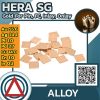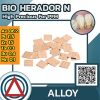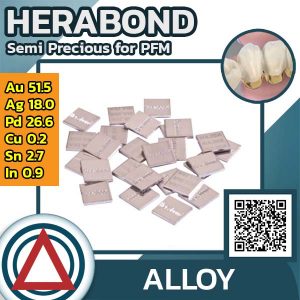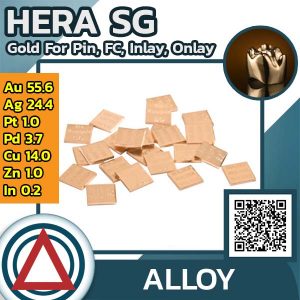Bio Maingold SG (ราคาปรับตามราคาตลาดโลก)
High gold content dental casting alloy (สีเหลือง)
acc. to EN ISO 22674
ข้อได้เปรียบ
– มีส่วนประกอบของ Gold อยู่ 71.0 mass % (ส่วนประกอบของ precious-metal 75.0 mass %)
– ไม่มีส่วนผสมของ Palladium
– ใช้งานง่ายกับระบบ milling
– ง่ายต่อการขัดมันและขัดเรียบ (polishing)
– ไม่มีส่วนผสมที่ได้จาก Beryllium และ Cadmium
– ใช้งานได้หลายรูปแบบ ตั้งแต่ inlays จนถึง Bridges แบบยาว
ประเภทงานที่เหมาะ
– Inlays
– MOD inlays
– Crowns
– Bridges
– Milling procedures
– Cast posts
– Implants
แอดไลน์เพื่อสอบถามราคาและโปรโมชั่น
Add to Wishlist
Add to Wishlist
Description

High gold content dental casting alloy acc. to EN ISO 22674 |
|
| Type | 4 (w/ v) |
| Shade | dark yellow |
| Indication | 1,2,3,4,5B,10,15 |
| Composition | Au 71.0 Ag 12.3 Pt 3.9 Cu 12.2 Zn 0.5 Ir 0.1 |
Technical specifications, melting and casting |
|
| Melting range | 875 ° – 920 ° C |
| Preheating temperature | 700° C |
| Casting temperature | 1050 ° C |
| Crucible | Graphite |
| Density | 15.4 g/cm3 |
| Hardness (HV5) | 160 (w/k), 250 (v), 250 (s) |
| 0.2 % yield strength (MPa) | 380 (w/k), 630 (v) |
| Elongation (%) | 42 (w/k), 16 (v) |
| Young’s modulus of elasticity (GPa) | 99 |
| Ceramic firing | |
| CTE | — |
| Oxide firing | — |
| Soft annealing | 750 ° C/ 5 min. |
| Hardening | 350° C/ 15 min. |
| Solder/laser welding wire | |
| Solder | Herador / Maingold PF solder 800 Maingold PF solder 750 |
| Laser welding wires | Ø 0.5 mm x 200 mm + Ø 0.3 mm x 200 mm |
x = content < 0.1 mass%
Indications:
1 Inlays, cervical filling
2 MOD Inlays
3 Crowns
4 Bridges
5 Milling technique
6 Partial dentures
10 Cast posts
14 Can be veneered with high expansion, low-fusing ceramics
15 Implant restorations
16 Electroformed double crown technique (primary crowns)
1 Inlays, cervical filling
2 MOD Inlays
3 Crowns
4 Bridges
5 Milling technique
6 Partial dentures
10 Cast posts
14 Can be veneered with high expansion, low-fusing ceramics
15 Implant restorations
16 Electroformed double crown technique (primary crowns)
Footnotes:
w = after soft annealing and quenching
k = ceramic bonding alloy: condition after ceramic firing
v = after hardening
s = self-hardening after slow cooling in the mould
w = after soft annealing and quenching
k = ceramic bonding alloy: condition after ceramic firing
v = after hardening
s = self-hardening after slow cooling in the mould
A = A stable framework design with reinforced connections with a cross section of 8 – 10 mm² is required for long span bridges and superstructures. Additionally, the frameworks need to be hardened.
B = Depending on the copper content, in some cases discolouration ofdouble crowns may result after short period of wearing. Discolouration, however, is technically and physiologically harmless.
C = In exceptional cases these alloys can also be used for traditional telescopic crowns with parallel walls and for the bar casting technique provided that cross-sections for crown walls, approximal areas, bars and laser welded joints are particularly thick and the alloy is hardened subsequently. No indication for conical crowns and sheardistributors.
B = Depending on the copper content, in some cases discolouration ofdouble crowns may result after short period of wearing. Discolouration, however, is technically and physiologically harmless.
C = In exceptional cases these alloys can also be used for traditional telescopic crowns with parallel walls and for the bar casting technique provided that cross-sections for crown walls, approximal areas, bars and laser welded joints are particularly thick and the alloy is hardened subsequently. No indication for conical crowns and sheardistributors.







